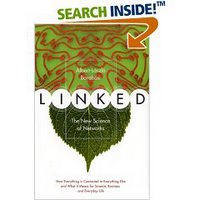Marketing Tool: Social Networking
 Linked
LinkedA new mathematical theory around the issue of networks evolved by the late 90' and one interesting instance of this theory can be found in the book Linked: The New Science of Networks. The theory created a new mathematical profession that brings with it a new set of thinking that enables the development of many new implementations that could not appear before.
Networking: The term is used for describing the act of managing your contacts. 'Networking' meetings are conducted today by most high prestige universities and other marketing and non-marketing managers who understand the advantage of it. The more connections you have in your network, the more people you can potentially have business with.
Concentrators: This are the most connected people in your net. Connecting to such person will potentially bring you much more connections now and in the future.
Information sharing is some kind of social behavior. 'Sharing' means not just files, music and movies, which is illegal, but rather share your ideas, share your doing, share your knowledge and connections, etc. The basic idea of the sharing model is that the more you give to the society the more the society will be able to give you back, due to the fact that massive cooperation and acts under this mantra will lower the entry barriers for acquiring knowledge. This principal can be rationalize through the understanding of globalization, as I described in the post The World Is Flat, but we will not discuss this issue again here. However, I would like to show some application examples that are using the globalization.
Sharing and Networking complements each other. We can not make an effective share unless we have a network connection, and from the other hand, our network will not be strong enough unless we have something in common to share. The theory can goes on and on, but I would like to show some applications. The one that I liked most is LinkedIn, but there are many other social networks (Plaxo, hi5, Ask My Network, ecademy and more) out there. LinkedIn for example is a network of connections between people that enables leverage the connectivity for business by finding connection shortcuts with people through friends and friends of friends, or even find a job and locate a relative someone that you can approach through the mutual connections that you have in the linked network. Using the network for business extremely enables the transformation of "cold calls" to "worm calls". Since the linked theory is new, I expect more and more applications to rise in the near future. Another example of networking and linked implementations is the Tagging and social bookmarking phenomena. These will be dealt in a future post. Meanwhile, start to build your LinkedIn network, you'll never know what fortune it might bring you back...
 Site Feed
Site Feed